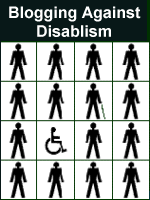I'm angry.
I've been angry since Thursday afternoon, and I'm
still angry.
I have ranted to the people who know about these things and who are professionals in the same field. They have confirmed that, faced with the same situation, they would
also be angry.
Very angry. This knowledge, although gratifying, has not, unfortunately, rendered me significantly
less angry.
So this is blogging as catharsis. Don't feel under any obligation to read any further.
In a nutshell, I am being barracked by a severely non-disabled fuckwit who is labouring under the delusion that equality in employment for people who "suffer from a disability" equates to letting them carry on being worse than useless at a particular job because it's rotten for them that they are afflicted with this terrible condition, so we should be kind and forgiving. Even when they do something so staggeringly unprofessional that there aren't enough words in the world to describe one's reaction to it.
Now, I'm probably re-stating here what I've said many times before, but
I need to write it even if
you don't need to read it.
Disability equality is about disabled people being treated equally.The DDA is, admittedly, the only piece of equality legislation which permits positive discrimination. But it only permits positive discrimination up to the point at which the people it protects are receiving equal treatment to the rest of society.
From an employment perspective, this means that someone covered by the DDA has the right to have reasonable adjustments made which will put them on a level playing field with their non-disabled peers. Reasonable adjustments are statutory positive discrimination.
What the DDA does
not demand - and neither should it - is that disabled people should be paid to work in jobs for which they are completely unsuited, and that their employers should turn a blind eye to how rubbish they are at what they're being paid to do because, oh God, it must be dreadful and appalling to "suffer from a disability".
We are the only minority group for whom people feel sorry: this makes disability discrimination very difficult to tackle. The severely non-disabled fuckwit to whom I referred earlier thinks he is supporting the right to equality of the hopelessly crap crip in question by insisting that it would be unkind to discipline him for behaviour which, if it came from a non-disabled person, would immediately and unquestionably be subject to disciplinary procedures. Can I persuade him that
his approach is the one which is disablist, not
mine? Of course I can't. Pity is so inherent in his response to impairment that it's impossible for him to get past it.
What's worse is that so many disabled people in employment fall into exactly the same trap, thereby confirming the prejudice. When I pulled someone up recently for his use of the word "handicapped" in a training module, he wanted to argue the toss with me about whether it's an acceptable word or not. "I spoke to a woman in our office who is wheelchair-bound, and she confirmed that she sees her wheelchair as a handicap.". Oh, right. So, just because this woman feels sorry for herself, and is as yet uneducated in disability equality, that makes it OK for an organisation which has publicly declared itself to be allied with the social model of disability to use the "h" word in its publications, does it?
And why exactly is it that, if I were quality assuring your draft training module with my
other professional hat on, you wouldn't
dream of telling me you think you were right all along and I'm just being needlessly picky? But as soon as it comes to disability equality, well, that's about
people, isn't it? And, because you've got an
opinion about things which are about people, you naturally assume that the expertise I've gained over more than a decade working in disability equality is
also just an opinion and, as such, no more valid than yours? I mean, God forbid you should recognise that expertise in equality should be accorded the same degree of professional respect as expertise in any other technically-demanding professional specialism.
Ahem. Anyway. Back to the topic in hand.
In employment, as in every other aspect of the average crip in the street's life, your thinking will remain muddled unless you have grasped the difference between equality (something to which you are legally entitled) and the impact of your impairment/s (something which the law can't alter.)
If equality is what you are after (and I would very much hope that it
is), you need to recognise that you will not achieve it by presenting your colleagues with a four-page essay on what it is like to have to live with a hideous impairment.
The acrobatics you have to perform in order to get your knickers on in the morning are
your business. I work with a team of people I like and respect, but I can tell you now that I don't want to think about how any of them clean their bums after they've had a poo. And, despite the fact that my own approach to this very personal task will be markedly different from theirs, I'm pretty damn sure that they wouldn't want to think about me doing it,
either.
I'm even
more sure that there is nothing on God's green earth which could persuade me to
tell them about it.
And yet I have lost count of the number of personal stories of that nature which I have seen in the workplace over the years. Groups of disabled staff have concluded that things would be better for them at work if their colleagues had a better understanding of what they go through on a daily basis. In other words, they want their colleagues and managers to feel sorry for them, and make allowances accordingly.
I've said it before, and I'll say it again. (What is it Heathcliff says? "I repeat it til my tongue stiffens"? Something like that.)
You will never be considered to be equal by people who feel sorry for you.I can't stop you feeling sorry for yourself. (And, if you think
I don't often feel sorry for myself, you are severely mistaken.) But I
will point out that we are the
only minority group which makes the illogical assumption that telling people - in gory detail - what it's like to
be us will make them treat us as equals. Do our LGBT colleagues publish articles for their colleagues to read about what it's like making love to a same-sex partner? Of
course they don't. Their colleagues don't
want to know, and
they don't want their colleagues to know.
But
us? Oh,
we write things like, "I can barely move when I wake up in the morning. My husband has to help me get dressed. Coming down the stairs is very painful for me.".
And, despite the fact that the minutiae of our personal lives is nobody else's business, most people will lap that sort of detail up greedily and then look round for more. Because cripdom exerts a curious fascination over non-disabled people. Encourage them to see you as a collection of intriguing symptoms and revolting bodily oozings rather than just as a colleague who is entitled to various adjustments, and they
will do so. You might as well just set yourself up in a booth at the end of your nearest pier and be done with it.
Look. It's like this. Even on those occasions when the DDA is firing on all cylinders in your workplace, the most it will achieve is what it was
designed to achieve: it will eradicate discrimination against you.
It
won't make your impairment go away.
It
won't allow you to do any job you like the look of, regardless of whether you have the necessary qualifications or aptitude.
It
also won't allow you to do any job you like the look of, regardless of whether it is feasible to make sufficient adjustment for you to be able to perform in that role.
Life
isn't fair. Disability equality won't enable you to take part in an Olympic skipping contest if your legs are paralysed. Disability equality won't "make you better". It won't solve all your problems. You will still have to live with your impairment. That will be easi
er than it is now but, in the vast majority of cases, it still won't be easy.
And we won't get equality
at all if we can't resist encouraging the normies to pity us.
Rant mode now disabled.
The Editor

















